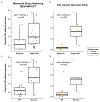Comprehensive Genomic Analysis of Translocation Renal Cell Carcinoma Reveals Copy-Number Variations as Drivers of Disease Progression
- PMID: 32220885
- PMCID: PMC7367714
- DOI: 10.1158/1078-0432.CCR-19-3283
Comprehensive Genomic Analysis of Translocation Renal Cell Carcinoma Reveals Copy-Number Variations as Drivers of Disease Progression
Abstract
Purpose: Translocation renal cell carcinoma (tRCC) is a rare, aggressive renal cell carcinoma (RCC) subtype. There is currently limited understanding on the role of molecular alterations in the pathogenesis and progression of these tumors. We investigated the association between somatic alterations and clinical outcomes in two independent cohorts profiled using DNA sequencing.
Experimental design: Twenty-two tRCCs underwent targeted sequencing [Memorial Sloan Kettering Cancer Center (MSK)-IMPACT]; a subset was profiled using exome-sequencing and combined with exome data from The Cancer Genome Atlas (TCGA) for analysis. The prognostic value of specific somatic aberrations, tumor mutation burden (TMB), and fraction of copy-number-altered genome (FCNAg) was explored. In TCGA cases, neoantigen prediction and immune cell deconvolution were performed using RNA-sequencing and exome data. Overall survival estimates were computed using the Kaplan-Meier method; time-on-treatment was calculated for 14 MSK-IMPACT patients who underwent systemic therapy. Associations between molecular features and outcomes were evaluated using nonparametric testing.
Results: Copy-number aberrant tRCCs were associated with poor overall survival (P = 0.03). Pediatric patients had tumors with lower FCNAg (P = 0.01). In one adult case with two chronologically distinct tumor samples sequenced, we confirmed that copy-number events occurred early during evolution. TERT promoter mutations were found exclusively in high-stage tumors. We found that tRCCs displayed distinct angiogenesis and PD-L1 gene expression profiles compared with other RCC subtypes.
Conclusions: Tumors molecularly defined by increased copy-number variations were associated with aggressive disease in tRCC. A higher burden of genomic events in adults compared with pediatric cases likely reflects a more aggressive clinical course. The unique immunophenotypic characteristics of tRCC merit further exploration.
©2020 American Association for Cancer Research.
Figures






References
-
- Ross H, Argani P. Xp11 translocation renal cell carcinoma. Pathology. 2010;42:369–73. - PubMed
-
- Magers MJ, Udager AM, Mehra R. MiT Family Translocation-Associated Renal Cell Carcinoma: A Contemporary Update With Emphasis on Morphologic, Immunophenotypic, and Molecular Mimics. Arch Pathol Lab Med. 2015;139:1224–33. - PubMed
Publication types
MeSH terms
Substances
Grants and funding
LinkOut - more resources
Full Text Sources
Medical
Research Materials

